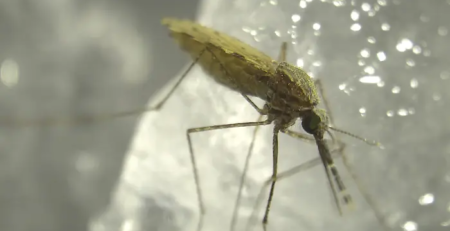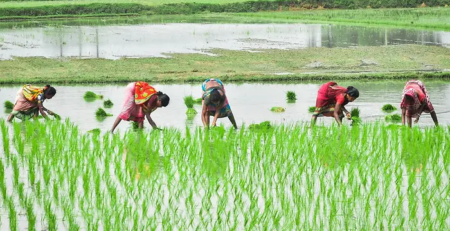Increased agricultural production and sustainable food security is of utmost importance for a rapidly increasing global population; however, current efforts in the production of agricultural food crops may not be sufficient to provide sustainable solutions unless innovative technologies are adopted to produce food with higher quantity and better quality. Rice is one of the most important staple food crops and is an intensive user of fresh water, which accounts for more than half of all the fresh water used in agriculture. With declining availability of cultivable land and water coupled with pest load, a rapid and sustained increase in productivity is becoming the only solution to feed the ever-increasing population. It is hypothesized that when the biotic stress tolerance traits are introgressed into the genetic background of elite cultivars, it can sustain rice yields as well as save substantial amounts of water. New genetic technologies such as genome editing by CRISPR/Cas (Clustered Regularly Interspaced Short Palindromic Repeats/CRISPR-associated protein) can be harnessed to achieve sustainability in agriculture by modifying target genes precisely without any penalty on crop performance. This technology potentially enables us to edit native genes for better agronomic traits, eliminating the need for a transgene in subsequent generations. These tools can be used to accelerate the process of generating rice cultivars for target environments.
The major goal of our group is to deliver transgene-free improved rice varieties through genome editing.
What inspired you to pursue a career in STEM?
I think it was way back in my school days, when I visited a science exhibition organized by a medical college near my hometown. That was the first time I thought about pursuing career in STEM.
What motivates you to pursue your research in plant genetics?
My passion in agricultural practices and the circumstances in which I grew up led me to choose plant sciences. The appetite to keep exploring deeper into the ambit of plant science had started building up during my college days. Even though I understood very little of what it would be like to be a scientist, and though there were plenty of tasks and barriers to overcome on this journey, what never failed to inspire me was the support that I received at every stage of my training and career.
As a part of the capacity building initiatives at TIGS, what is your outlook on the program? What advice would you give young researchers?
With the support from TIGS management, Tata Trusts, NCBS and inStem, we were able to develop a world-class facility to find solutions to some of the healthcare and agricultural needs in India. Now all we need is to focus on target traits and deliverables. The young generation is very smart and able to adopt new technologies very quickly. They are very passionate about the research that they are involved in at TIGS.
What are your thoughts on the need for encouraging R&D efforts in India?
I will comment particularly on the agriculture sector; our government is actively supporting R&D efforts in the public domain through various schemes and grants. On the other hand, we are also regularly hearing about many agriculture-based industries, both national and international, either scaling down their research efforts or completely shutting down their facilities. The research community expects quick decisions on guidelines and policies for developing a product and making it available for farmers. This will certainly impact our mission to sustainably increase crop productivity to meet the growing demands of an increasing population. Otherwise, we will be very much behind in taking advantage of GM and GE crops, compared to other countries that are benefitting from them.
Considering India’s efforts in addressing issues in malnutrition and farmer woes, what is your view on how crops with improved agronomic traits can make a difference?
Successful development of crop varieties with improved agronomic traits associated with yield, disease resistance, and abiotic stress tolerance traits will have a great impact on agricultural productivity. The majority of the studies indicate that new breeding technologies, like genome editing, offer more opportunities to produce crops with improved agronomic performance, product quality, farmer profitability (lower production cost, higher income), climate resilience, and food security. These advantages derived from the accuracy and precision of genome editing technology could help save time and lower the cost to produce improved crop varieties. However, crop genetic research requires support from the public, policy makers, and government to reap benefits in less time and with reduced costs.
The adoption and deployment of new technologies like CRISPR come with their own set of challenges. How do you think scientists and research institutes can overcome them?
Before adopting any new technology for product development, one must understand the technical feasibility, regulatory policy, and intellectual property rights associated with it. There are several online tools available to select unique target sequences for efficient genome editing with minimal off-target effects. The next step is to achieve efficient delivery of CRISPR components into plant cells to obtain targeted gene modifications. However, many crop species and leading varieties are recalcitrant and extremely difficult to transform. So, it is highly essential to develop tissue culture and transformation protocols for efficient delivery of CRISPR components. In crops, many important traits are multigenic and one must develop proper editing strategy to target specific gene or genes for obtaining the desired phenotype. Finally, the CRISPR cassettes used to create specific edits need to be removed from the plant genome; this can be achieved through backcross experiments.
What do you think is the best approach to addressing myths and misinformation surrounding GM crops?
There is no doubt that genetically modified organisms haven’t had a good reputation, and it is a topic of intense debate that has triggered a lot of controversy over the years. It is powered largely through lack of understanding and misinformation. However, public acceptance will improve when consumers see the direct benefits of GM crops. The best approach is to provide awareness about GM crops; scientists and academicians should conduct workshops and training programs to educate the public, farmers, environmental and consumer protection groups as well as non-government organizations on the benefits and safety of GM crops. On the other hand, government agencies also should act quickly to take go- or no-go scientific information-based decisions on any specific GM crop seeking approval for releasing into market.











